#brunei history
Explore tagged Tumblr posts
Text
SALEHA BOLKIAH // QUEEN OF BRUNEI
“She is a member of the royal family as the wife of Sultan Hassanal Bolkiah. She is the daughter of Pengiran Anak Mohamed Alam and Pengiran Anak Besar. After her husband was crowned as the Sultan and Yang Di-Pertuan of Brunei, she succeeded her mother-in-law, Pengiran Anak Damit, as Raja Isteri (queen consort).”


1 note
·
View note
Text

#Bentley#Sultan of Brunei#Prince Jefri#Bentley Dominator#luxury cars#automotive industry#financial history#car enthusiasts#cars
93 notes
·
View notes
Text
Discovering Brunei: A Jewel of Southeast Asia
Nestled on the northern coast of the island of Borneo, Brunei is a small yet fascinating country that often goes unnoticed by many travelers. Officially known as the Nation of Brunei, the Abode of Peace (Negara Brunei Darussalam), this sultanate offers a unique blend of rich history, lush landscapes, and a distinctive cultural heritage. A Brief History of Brunei Brunei’s history dates back to…

View On WordPress
#" this water village is home to over 30#000 people. Jame&039; Asr Hassanil Bolkiah Mosque: The largest mosque in Brunei#A Brief History of Brunei#Accommodation and Affordability in Brunei#Accommodation in Brunei ranges from luxury hotels to budget guesthouses. While prices are generally higher than in neighboring countries#Activities for Tourists#Activities for Tourists in Brunei#adventure#africa#Airports and Infrastructure in Brunei#Ambuyat (a sago dish)#and a distinctive cultural heritage.#and a variety of fresh seafood.#and Indian flavors. Must-try dishes include Nasi Katok (rice with fried chicken and sambal)#and it significantly influences daily life and customs. The culture of Brunei is a mix of Malay traditions with Islamic influences#and larger shops. It&039;s still wise to carry some cash for smaller transactions. Q: What cultural norms should I be aware of? A: Dress mo#and the political environment is stable. However#and the sale of alcohol is prohibited. However#and vibrant culture. Whether you&039;re exploring its stunning mosques#and visitors will find a welcoming and respectful society.#Brunei became a British protectorate to prevent annexation by its more powerful neighbors. The British influence lasted until 1984 when Brun#Brunei controlled much of Borneo and parts of the Philippines.#Brunei has a relatively high cost of living compared to other Southeast Asian nations#Brunei International Airport (BWN) is the main gateway to the country#Brunei is a small yet fascinating country that often goes unnoticed by many travelers. Officially known as the Nation of Brunei#Brunei is an absolute monarchy where the Sultan wields extensive powers. The country has a stable political environment with no significant#Brunei is considered one of the safest countries in Southeast Asia. Crime rates are low#Brunei promises a memorable journey.#Brunei&039;s history dates back to the 7th century when it was part of the powerful Srivijaya Empire. The Sultanate of Brunei rose to promi#Bruneian cuisine is a delightful blend of Malay
0 notes
Text
youtube
Singapore, 1928
#singapore#malaysia#brunei#jakarta#hong kong#thailand#usa#dubai#australia#singaporean#kuwait#asian#asian culture#asian music#asian history#asian art#Youtube
1 note
·
View note
Text
Flag of Brunei

The national Flag of Brunei was embraced in 1959 when the country was an English protectorate, and was held when the country procured full opportunity on 1 January 1984 as Brunei Darussalam (Region of Brunei, Home of Congruity). Brunei is even one of just a modest bunch of extraordinary nations to obtain full political independence from the English domain without embracing one more flag to praise the event.
https://flagzworld.wordpress.com/2023/02/28/flag-of-brunei/
1 note
·
View note
Text
In the spirit of releasing all emotional debts on New Year's Eve, I’m going to open up about my frustrations regarding Desa aka dinosaurusgede aka the creator of Maaf.
For context, she made a Twitter account around the time that Himaruya properly introduced the newly canonized cast of SEA nations (Philippines, Indonesia, Singapore, and Malaysia). Like many other fans, she rode the nostalgia wave in creating content of them. By this point in time, Maaf was more or less a “finished” story to her — whatever Hetalia/SEAtalia content she published from that point onward was not as a continuation of, nor even as a reboot, of Maaf (although she did mention entertaining that idea). For the most part, the newer works she uploaded on Twitter were independent stories and were not necessarily linked to one other either.
Regrettably, I cannot present the problematic page/s for a more thorough and guided scrutiny because she deleted her Twitter account. Unless someone out there saved them, and frankly I wouldn't know who did nor would care to find out, everything was lost to the void. I’m literally working on what was imprinted in my memory by spite, so I apologize if I misremember details.
This will include discussion of anti-indigenous racism and other issues pertaining to colonialism.
She had an IndoPhil story titled Trust Me? and it was inspired by a fanmade BruPhil AMV wherein Indonesia was manipulating Philippines into believing that he was married to Indonesia and not Brunei. Trust Me? kept that concept of a manipulative Indonesia; the key difference being that Indonesia’s motivation for it (in Desa’s story) was the mix of hurt over Philippines “losing his precolonial memories” — based on popularized misconceptions of early Philippine history — of and how that was “aggravated” by his Westernization™, made worse under the United States (350+ years in the convent getting ratio'd by 50 years in Hollywood is hilarious ngl).
That was a lot to unpack, but before we even get there:
Indonesia and Philippines were having a tender moment when HWS America (as in the Hetalia personification that is Alfred F. Jones) walks in calling out "MY LITTLE BROWN BROTHER!"
Indonesia entered his Joker arc because he recalled how HWS America dumped the Philippines in a human zoo at the 1904 St. Louis World’s Fair. There was an explicit panel of Philippines in Igorot* dress and a painfully forlorn bearing.
What "triggered" Indonesia was when, after the flashback, Piri goes up to Indonesia and asks him if he's a Bolshevist 🥺 (the idea was PH being brainwashed by Red Scare propaganda). Cue kabedon moment from Indonesia, and basically a yandere walk down "memory lane."
I did not have it in me to finish reading that comic...
*Igorot is an outdated umbrella term for the upland indigenous peoples of Northern Luzon
Aside from the clearly intended shock value of that depiction, I was taken aback by the painful lack of objectivity on her part when it came to the reading of history. To be fair on Desa, she never specialized in history studies, so it was only courteous that we could not expect her to have as developed of a critical reading as trained academics of history. Unfortunately, that was precisely why I disagreed with the popular notion of Desa as both a great researcher and a great storyteller of her research — all the more when Maaf was just the mangafication of certain Wikipedia articles.
To be fair as well on Wikipedia, it was, at best, a satisfactory jumpstart into more in-depth reading, and we could give it the benefit of the doubt that revisions had since been made to at least some of the articles that Desa relied on while making Maaf (more than 10 years is more than enough time for change). Nevertheless, the articles themselves did not teach users how to scrutinize the sources — most especially the biases of the sources’ author/s — utilized in building up the information.
That mattered because much of the retrospect narratives about the St. Louis Fair had a tendency of raising awareness through the newspaper articles that covered the exhibition at the time. These chronicled the impressions of the visiting authors, who likely (and I say likely because we would have to more exhaustively discern their personal politics one by one) were biased in favor of the “benevolent assimilation” of the Philippines — and the sights that they beheld only validated it further. They did not, however, explain why these Philippine indigenous peoples were brought in in the first place — information that could have further cemented Desa's reputation had she truly spent the efforts, even while understandably juggling other commitments as we all do. Instead, she only perpetuated the habit of sacrificing the veracity of equally important, finer details to the bigger picture in order to sensationalize righteous fury against colonialism.
The 1904 St. Louis World’s Fair was also formally known as the Louisiana Purchase Exposition, giving away its purpose as a commemoration. More appropriately, it was the centennial anniversary (technically delayed by a year though) of the acquisition of French Louisiana, expanding the territorial bounds of the United States. Additionally, the point of a world’s fair was to showcase the achievements of a nation, and one could also think of it as the sale of a fever dream — what more for a fast-growing, fledgling power the likes of the United States, itself a former colony? On another note, the St. Louis World’s Fair was not the only one of its kind so no, the US is not that original lmao.
One could thus see how the inclusion of a dedicated exhibit to the newly acquired colony that was the Philippines neatly fit into the themes of a world's fair centralized on the US. It was all the more a paramount topic of debate, with prominent Americans the likes of Mark Twain (here are selected excerpts, but I highly recommend reading the entirety of his To the Person Sitting in the Darkness) publishing anti-US imperialism opinions, even after the endgame of the Philippine-American War essentially favored the pro-imperialists. While dissent from the American side at the time remains poorly studied AND THAT'S ON OVERRULE BY BIAS, we at least have a glimpse, if mostly obscure still, of its existence.
If we can assume that it must have indeed been a prominent discourse in America, loud enough to get the White House furrowing its brows, then it's plausible to understand how it was of utmost importance that the the Philippine exhibit was to be carefully — because, in a way, America had to sell itself as the "lesser evil" vs notable "rivals" — curated while still ultimately corroborating assimilation of the Philippines. Thus, enter Truman Hunt, the man who oversaw "the Igorot Village" of the St. Louis Fair, having won the hearts of the native Igorots for a powerful reason:
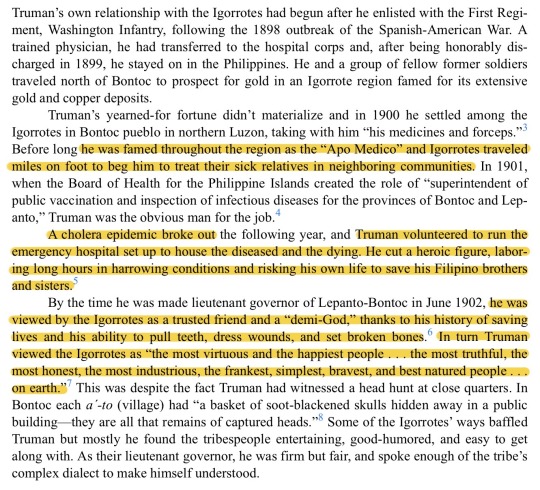
Section from Claire Prentice, The Lost Tribe of Coney Island: Headhunters, Luna Park, and the Man Who Pulled Off the Spectacle of the Century, New York, NY: Amazon Publishing, 2014.
While the cholera epidemic that occurred at the onset of the American Colonial Period was arguably the worst in the history of cholera epidemic management in the Philippines, I want to make it very, very clear that it was not the first and only wave that hit the archipelago. There had been a handful in the prior century alone — all of such magnitudes that it embedded a deep collective trauma; farmers refused to harvest their crops for fear of infection, tragically enabling famines and contributing starvation & nutrition deficiencies on top of a viral & swift killer (the experience of severe, rapid dehydration is such that one can fall dead within hours of infection).
Given such an imaginably harrowing experience (and it was an awfully painful topic to study as someone who got infected with and survived COVID-19 and has family working as frontliners), how could the natives turn away a stranger with such miraculous powers? Who knows how they comprehended it (e.g. a benevolent sign from heaven they must accept) because, unfortunately, we have yet to discuss preserved accounts on that matter, if any at all.
What is known, however, is that there were Igorots who were not just enamored by the "opportunity of a lifetime," but the selected lucky candidates clearly expressed their consent to participate:
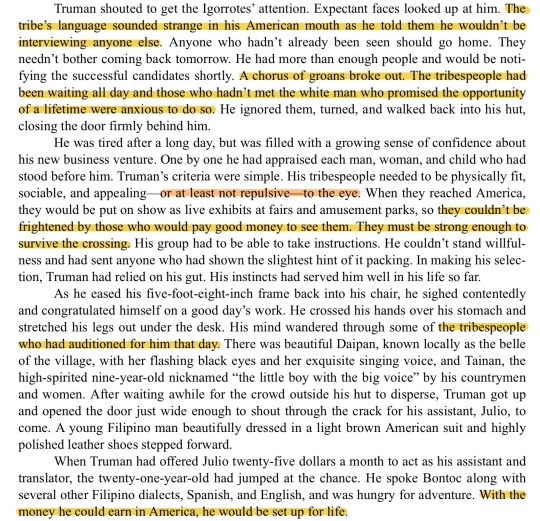
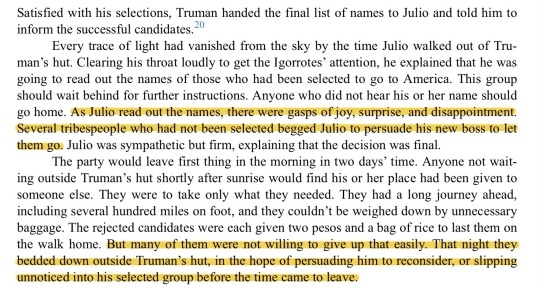
More sections from Prentice, The Lost Tribe of Coney Island.
I will quickly add that, unfortunately, a few members of the Igorot delegation died from illness in making the trip, and Hunt aged like milk over the years (fell into the trap of capitalism in pushing for more subsequent exhibit trips, to the point that less care was extended to the Igorots and he was ultimately arrested for embezzlement). Given that our scope remains to be the 1904 St. Louis Fair, any signs of abuse inflicted upon the Igorots during their stay based on preserved photographs is simply not clear. To assume that they were in a pitiable state would be to enforce a presentist reading that might betray not just their memories & experiences but also their right to self-determination.
EDIT (01/02/24): A good example to demonstrate what I mean in analyzing photographs, here's an article on the author's personal, genealogical research into the Igorots — specifically, the Suyoc — who were at the St. Louis Fair.
It truly is ironic that a Filipino is making these points as if to defend the United States as a whole (no I am not, and if you think I do, lumayas ka). I agree that white people gawking over the peoples of the Philippines with such fascination that borders fetishism warrants all the eye-rolls. At the same time — and it is even more ironic that I am pointing this out as a lowland, Christianized Tagalog based in the metro (not just any urbanized part of the country) — there is a character of patronizing these indigenous communities in the unspoken assumption that their participation is the fault of their ignorance. Pay attention, once more, to the demographics that constituted the Philippine exhibit in the 1904 St. Louis Fair — what kind of "Filipinos" were included and who were left out? There were also Negritos*, Visayans, and Muslims from Mindanao (historically referred to as Moros) in the same event, yet we hardly hear about their experiences. Perhaps it might have to do with how they were considered "more civilized" than these upland groups.
*OUTDATED term (and please blame the Spanish for it); these are the Aeta.
I understand Desa's reservations against US imperialism and sympathies for communities marginalized by Western colonization. I just hope that I was able to clarify as best as I could why I was so taken aback in how she depicted the Hetalia personification of my country the way she did. I agree that, as far as I ever got to interact with her, she is generally very polite and kind. That's why I gave her the benefit of the doubt when she approached me in DM to apologize for how her narrative choice was offensive. As someone who despised red tape in academia, I tried to talk to her about how there were valid reasons as to why the American Colonial Period was considered a mixed blessing, even by PH historians.
Instead, she pulled a complete 180.

She said that — to a Filipino who condemned imperialism (no matter who started it), who also happened to study history as a profession, and was also a Hetalia fan who wants to explore Hetalia narratives differently from what was popularized. Half of the reason was because some fandom takes left a bad taste, like eating a dish with ingredients that even Gordon Ramsay would tell you shouldn’t go together; the other half was because I saw things differently and wanted to express it because why not?
I want to say it's not necessary to bring up something from a private conversation, but I will anyway to reiterate that my issue is not that she isn't nice. Bluntly, however, the way she said those words so formally did creep me out, but ultimately, my issue lies in how her biases have led her into making off-putting takes from time to time. I will not say more, but Trust Me? was not the only Twitter comic by Desa that got bombastic side-eyes.
And if only because Sukarno got dragged in, I felt compelled to briefly debunk that as well: even he initially viewed the United States in a very positive light: “The United States occupies a very distinguished part, a very distinguished place, in the hearts of the Indonesian people.” That was uttered in 1961, and it took a very specific historical context to instigate a complete shift by 1964:
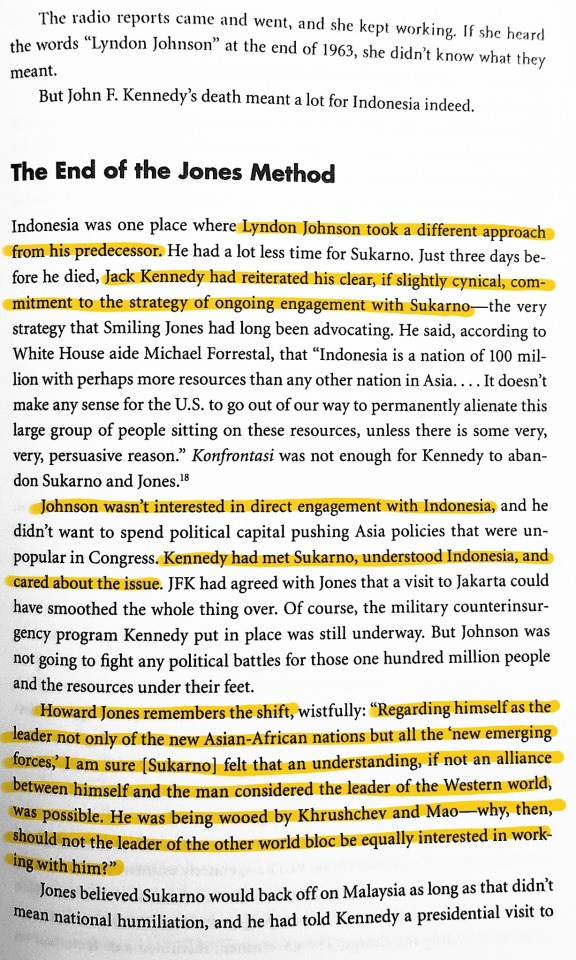
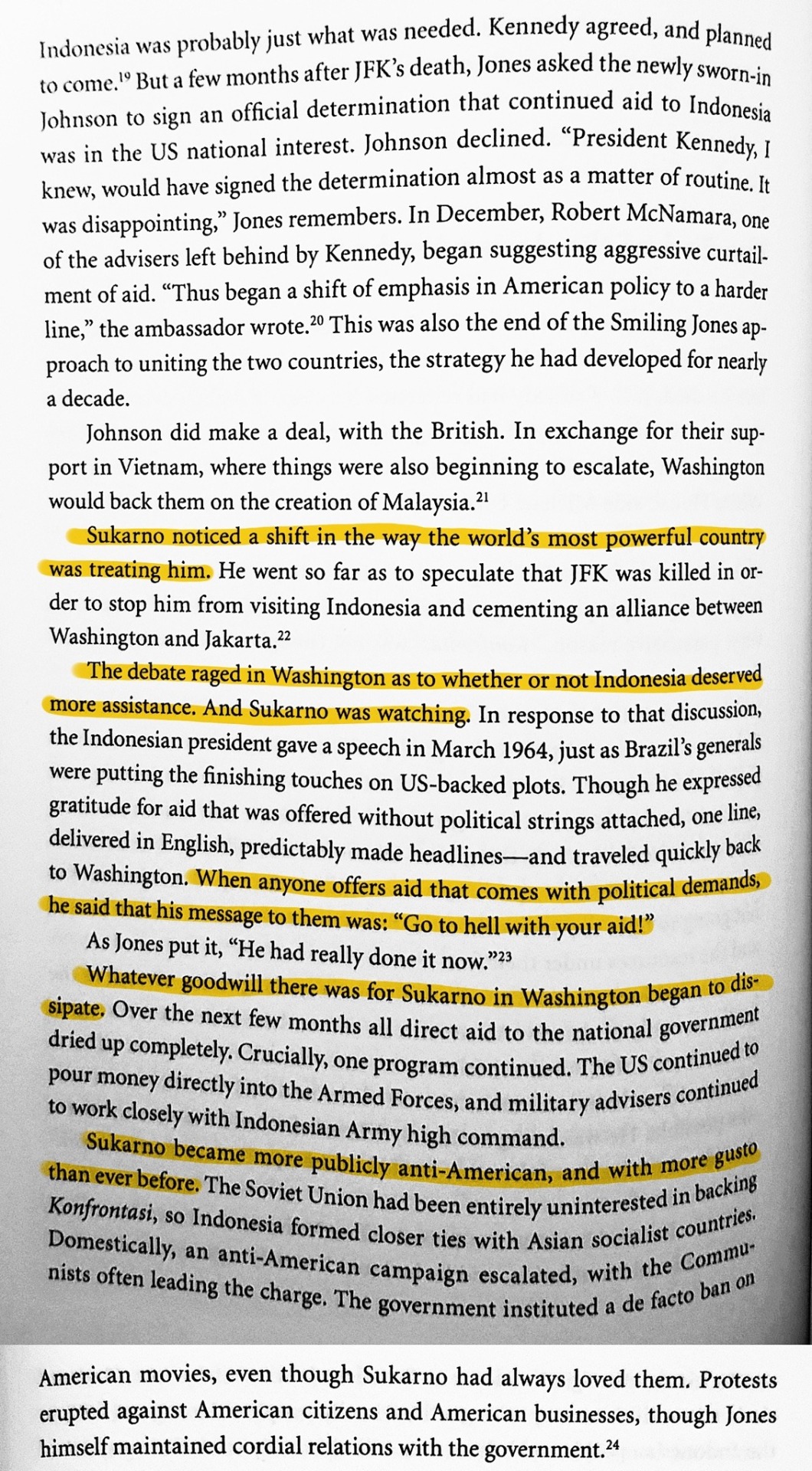
Sections from Vincent Bevins, The Jakarta Method: Washington’s Anticommunist Crusade & the Mass Murder Program that Shaped Our World, New York: PublicAffairs, 2021, 121-123.
EDIT (01/02/24): Note that Desa was citing Sukarno's later sentiments in the late 1960s as her reason for characterizing Indonesia as such in her comic. However, the setting of the story was the late 1920s (Indonesia's visit was based on Tan Malaka's abscondence to the Philippines). I'd dare say the anachronism was not due to oversight but a deliberate choice in using a certain fictional character — namely HWS Indonesia — as propaganda for Desa's anti-Americanism.
It's definitely depressing to think about all the "lost" history & culture that thrived before the arrival of white colonizers. It's why I'm surprised that, for a fiction work, she didn't project all that anger onto Spain instead — it had to specifically be the United States. Was it because they basically cockblocked Philippine independence, even though Spain practically sold the Philippines to the US? The implication that Spain should be permitted to wash its hands clean of all accountability was an awkward message to convey.
I understand that nothing could be 100% accurate (I'm actually quoting Desa defending herself on that matter) in fiction, but the level of projection coming from a certain non-Filipino reading Philippine history was so silly. And again, how did it all justify the explicit depiction of HWS Philippines as an indigenous man in a human zoo? (END OF EDIT)
As my professors will also never tire of saying: you can disagree with a historian’s interpretations but you can never disagree with the evidence in themselves. You don’t have to morally agree either, and I can guarantee you that many Filipinos do not. I, myself, resented the endgame of the particular war that brought that period about in the first place. How dare, then, she said it was “not her place” to defend US imperialism, while granting herself the freedom to express her country’s feelings on the matter?
Oh, it’s all just fiction? I do not condone the subsequent treatment she received, but why then couldn’t she stop trying to “educate” NLID shippers? I do not know how both sides talked to one another, only that what caught me eye was: Why does everyone else have to respect her fiction while she gets to disrespect others’ fictions for not aligning with hers?
EDIT (01/20/24): Just to clarify further on that point — over a decade ago, she went ham in the comment section of someone's (APH) America x (fem!OC) Indonesia. That ship is not in my lore either simply because I follow a totally different route. To cut to the chase, she took that fanart very personally and infodumped on US war crimes that involved Indonesia.
I know Tan Malaka started the whole North Indonesia agenda, but come on, neither was it Desa's place to just treat HWS Philippines the way she did. An Indonesian schooling other Indonesians on ID history is not surprising, but an Indonesian schooling a Filipino on PH history? I'd be humbled if they had the credentials. She didn't and, unless she enrolled herself in a graduate program, she still doesn't.
By all technicalities, she can’t ship IDPH because the Philippine government was (unfortunately and grossly) complicit in the chain of events that led to the 1965-66 genocides in Indonesia. Yet, she does despite of that fact. We thus circle back to Trust Me? and how that was a manifestation of her stubborn refusal to acknowledge any nuances by projecting HWS Indonesia as a self-proclaimed savior of HWS Philippines from the beguile of US neocolonialism.
I empathize with her anger. I'm sorry that the US government by extent enabled what her family went through. I agree that it's not her place to defend them; in fact, she shouldn't. But when even the so-called "highest of Malay nations*" is worth her neutrality, how can she expect me to forgive her?
*That is literally what the Philippines is to her; I know this because she explicitly said so to me in DM. DO NOT ASK FOR RECEIPTS, I am not comfortable revealing that particular conversation.
I cannot — in fact, NO ONE SHOULD — afford to be neutral about Duterte or Marcos, etc., and for her to be so flippant about her privilege (by way of ethnicity/citizenship/cultural upbringing) to be neutral** about Philippine politics, while simultaneously NAGGING ON EVERYBODY TO RESPECT INDONESIAN POLITICS, is annoying at best and plain selfish at worst.
**Also explicitly said to me in DM. Again, DO NOT ASK FOR RECEIPTS.
(END OF EDIT)
I’m not Indonesian but I do not have it in me to politely accuse a native Indonesian of allowing their personal biases to misread their own history. As a Filipino, however, while I'm not surprised by the reductionist chronicling of the histories & cultures of the Philippines, I am at a loss for words over the continuing idolization for Desa & Maaf, when she was not the best and most reliable narrator, especially given her negligence in representing indigenous peoples through her comics.
I mean, guys, I'm not saying this as if the Trust Me? comic was the first and only instance when this was literally Maaf canon that sat comfortably in the internet for over a decade, and continues to be appraised as THE BIBLE OF HISTORICAL HETALIA.

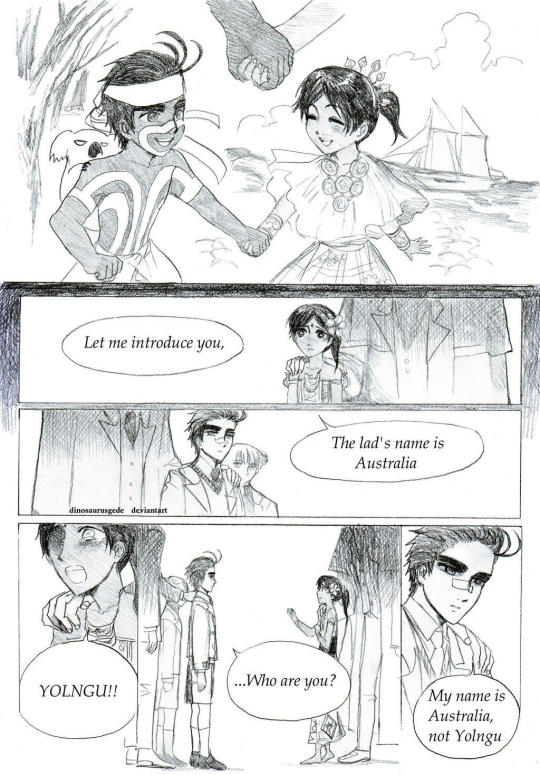
EDIT (01/20/24 — originally added via a reblog): I cannot believe this needs to be said because this is the consequence of when Hetalia fans take their fiction too literally because creators have made careless takes.
There were SEAtalians joking about how the Yolngu are a dead people.
I repeat.
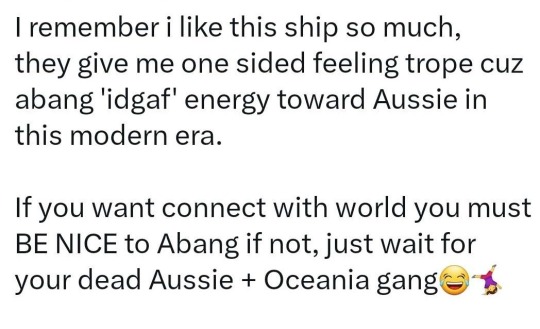
THERE WERE SEATALIANS JOKING ABOUT HOW THE YOLNGU ARE A DEAD PEOPLE.
(END OF EDIT)
So as 2023 comes to a close we enter 2024, I'd like to conclude this post with the following points:
At best, Wikipedia is a satisfactory jumping point, but please believe me when I say no historian will respect you for (over-)relying on Wikipedia. And given that anyone with a decent device & internet signal can access Wikipedia, Desa is just not a GOAT in historical research.
At worst, idolizing Maaf patronizes the work of historians. It doesn't help that PH historians have been targets of harassment because of dis-/misinformation campaigns. I bring this up because it's already bad enough to have to confront that reality outside of fandom spaces on a regular basis in standing our ground for more just historical truths. I hope that folks understand why that's a particularly sensitive struggle for me, and why receiving such comments like the one I shared above deeply hurt. She was not apologetic about that — and every time she would post about apologizing for the moments she has offended others, or when others compliment her for being so open-minded, I cannot help but feel bitter.
Other BIPOC — yes, not just other SEAsians and that's on literally drawing nations other than SEA — have spoken up on the matter. If you can talk about how you learned so much from Desa, you can also learn as much from other perspectives. I hope that in raising all of this, more SEAtalians understand that we risk othering non-SEA BIPOC.
The idolization of Maaf (and the creator in question) is personally far more off-putting than the problematic points of Maaf or any comic she has ever made, because I think she caved to peer pressure instead of learning to wield her fiction more sensitively without being too reliant of the opinions of those she has pleased. Not even Hidekaz Himaruya writes his nationverse characters like that — the one time I’ll admit that canon trumps fanon.
I’m not stopping people from liking Maaf or Desa anyway. I just cannot help but take issue with how the SEAtalia fandom feels less of a safe & inclusive community than it is a cult centered on one person — almost as if her fiction is unquestionable canon and anyone who disagrees gets the boot. Once again, I do not condone the subsequent treatment she received in retaliation, but frankly that's just not what I'm addressing here.
I'm also not saying it's wrong to give words of reassurance and validation to people you admire, only that some of you need to understand you're forcing a parasocial relationship with your idols. It may feel good to you, but please be mindful of the unwarranted pressure it imposes.
I apologize for dumping all of this at literally the end of the year. I want to let it all go in a manner that is clear, concise, and not overwhelming to digest. I do hope that my candid thoughts will push the fandom one step forward in critically consuming media without having to resort to crab-mentality tendencies — because it's been especially hard seeing the demeaning takes made about the Philippines in this fandom.
#hetalia#historical hetalia#hetalia critical#racism cw#hws philippines#aph philippines#hws indonesia#aph indonesia#hws america#aph america#mentions of death cw#sibuyas
53 notes
·
View notes
Text
Today's generation and with slightly full of hatred on other side society. Could be hard to over populate Brunei Darussalam. But with great distraction 📺🧠😒🤕🧠🧟♀️🧟♂️👻 (which is me). The future of Brunei Darussalam can make it.
"It's been 84 years."
youtube
"You're welcome."
youtube
Who these
youtube
"Just stay away from me!! You're a coward!!"
"Great food. Thanks for having time to meet meeting me."
*Hit his balls/penis.* If he wanna make baby again. Because im broke. Wtf. Until I get my birth control pill. Thank you very much doctors. You getting paid by rasuah or gaji? How much is it? "Not enough." Too bad. Jangantah berkraja di Brunei Darussalam then?! Bagi tia job mu ah arah orang lain!! Paidah!! Banyak lagi orang Brunei Darussalam kan jadi doctors. Banyak lagi kan difikirkan dang dang!! Kan suruh aku balik2 ke clinic? Jangan harap. Kau ganya kan difikirkan kah?! 🗣️🏴☠️🇧🇳. Atu banar!! Balik karang arah slums di negri mu yang over populated ah. "Mah-hu?!" I have smelly pookie and smelly body odor you think that's a coincidence?! I don't think so yew whores. Jangan jadi jahat. 🇧🇳🏴☠️.
Divergent movie i live gah
youtube
youtube
youtube
youtube
Mendera anak. Ngah dyg pun mendera dulu. Aku nampak cats nya yg basar2, tapi masih jua ia marahi anaknya. I don't like 🐈🐕🐦 cause they don't do anything to over populate Brunei Darussalam. Aku pun sikit lagi mental. Hafizul was very mental pasal ia belum tidur 2-3 hari? (Siapa jua inda mental kalau balum tidur. "okie"). Aku marahi pasal Khaleed nangis tangah2 malam, ertinya mahu nenen. Sebelum aku jadi pendera, Hafizul mesti sakiti aku. Sakiti hati ku pun ada jua (banyak 🤣😂). So it can reminds me of my faults (ill find you when im dead 🏴☠️🇧🇳🧙🏻♀️🧙🏻♂️). I try not to explode. Or else I'll die. Geez. 🏴☠️🇧🇳
Manatahu kau nanti terkana.. Like.. Car accident? Car crash? Pendera (sekali saja, don't push it, control)? Pemarah (tapi mama inda sampai tangan. Arah ku sampai tangan pulang)? Kana rasuk? Kahwin 2-3-4 orang bini? Divorcee? Gigi problem? Eye got stabbed? Tergelincir di jamban sampai mati? Cacat? Kana keluarkan dari master bedroom? Ada car but with no aircond? Kana marahi oleh boss inda suruh bekraja lagi must stay di rumah buat chores just live life (lmao, kalau malar kana serbu aku ani pasal stay di rumah kana pajal suruh bekraja untuk orang 🇵🇭 atu bana.... 🤌🏼?🫶🏼? Ew. Sendiri tah kau berkayuh🚲 🤣😂🎬🎥)? Kana tinggalkan somewhere else oleh laki and then laki lupa pick up bini? Jalan2 kaki jauh2? Patah tulang? Sakit pinggang macam orang tua? Sakit tua di katil? Keguguran? Curi cucu (but his/her future wife/husband will kill you.)? Penjara? Drug? Pookie berbau?! Badan berbau macam bau sampah or bau bangkai?! Eczema?!
Entah apa history family mu masa dulu2. Baik tah kau research, tanya saudara-mara mu baik. Ada ciri2 pendera jua pakah. Ku liat ciri2 pemental ada jua. Penjahat. Indakan penjahat. Kana rasuki 🇧🇳🏴☠️?? Baiktah bawa berubat.
Bagi hairan jua tu ah. Malar ku fikirkan, "Kenapakan ia malar target aku ani ah? Suruh aku berubat lah, suruh aku ke mental ward lah 😑". Jangan2 ia yang patut berubat. Jangan2 history family mu ada pernah ke mental ward. 🤕. Patutlah ada psycho ward di 🇧🇳🏴☠️.. I see it now. Apa masalah ku kan arah mu? Ada kah orang berguna kan laki mu? Ada kah orang berguna kan bini mu? Yang penting Stop kacau aku. STOP LIAT AKU. Mihir jua tu. You think is that fair?
Yang penting aku inda dapat selamatkan masalah mu dan masalah keluarga mu. Ok. Walau apa pun kejahatan kau mahu buat arah ku. Inda kana ampuni tu perbuatan mu atu. Pasal kau sendiri pakai/makan/minum/tidur/breathe apa saja yang kau buat atu. Basically. Living life. Sekian maklum.
Please watch this movie 'Dead Silence' so you can sadar/know why.. Bawa baca doa penyejuk hat. Bawa sembahyang, cakap/berdoa dengan Allah. Bawatah berubat. Bawa dangar lagu metal pakah, dangar lagu Taylor Swift kah, dangar lagu Little Mix kah. Mana ku taho. Sometimes orang sekeliling ni ada jua sifat 🗣️🐦🐕. Hati-hati sha.
youtube
Tada
Tada
The most powerful women goes to....
youtube
When did this curse started entering 🇧🇳🏴☠️?
Curses. Something to think about.
Maybe greedie? Taxes?
youtube
Witches..
13 notes
·
View notes
Text

“i was scrolling through instagram to find more pictures of the wedding because it was gorgeous as hell! i swear in every picture anisha outserved mateen. but i came upon i guess one of anisha’s hate accounts back then and oh my god, the way those people spoke about her is so vile. like yes she did not have a stellar history, but i doubt she thought she would ever marry a fucking prince despite her family’s closeness to the royals. the way they hated her for having a bf before, clubbing and drinking, like mateen himself wasn’t doing that too? they both spent their 20s in europe where the culture is vastly different from the traditional, conservative asia, not just her. my guess is she wasn’t raised as a devout muslim like most in brunei. nonetheless it’s so incredibly misogynistic. they fat shamed her for having a baby face back then when she wasn’t even CLOSE to fat? slutshamed her for wearing bikinis while swimming in a pool? jumped to conclusions and accused her of breaking up one of mateen’s old relationships? no wonder she deactivated her instagram. what’s funny is they say all that and still cower behind a clear burner account. or they’re ugly😂 she doesn’t have that shining history people expect her to have, but she has clearly made big life changes to become the royal wife of a prince. like prince mateen, they seem like they’ve ended their reckless early 20s lifestyle. and it’s not like the bruneian royal family aren’t hypocrites anyway with that sultan’s brother’s sex scandal thing back then. oh and their thing with wearing and putting gold everywhere like it isn’t against islam. and inbreeding. yeah that too. anyway, i root for them! from the pictures i’ve seen, they seem like they married for love and i love that for them! i hope she’s his last partner. what a gorgeous couple.” - Submitted by Anonymous
25 notes
·
View notes
Text
i always think it is so fitting that the second european expeditionary forces into what would become the philippines were met with rajah matanda (“the old ruler”). this was the same rajah matanda who, as a young man still known as prince aki, had met europeans half a century earlier when the ship he was boarding was captured by them. he was the grandson of the sultan of brunei and son of the ruling lady of maynila. he succeeded his mother in between those two documented times in his life. he probably is one of the most important inter-era figures we have in philippine history.
9 notes
·
View notes
Text
No. 55 - British Airways, Part One - British (European) Airways and British (Overseas) Airways (Corporation)
British Airways.
Starting this post was harder than actually writing it. It's hard to start a post about British Airways, because it's a deceptively weird airline. If you very precisely altered my memory, kept my knowledge of the United Kingdom and of flag carriers but erased all I knew about British Airways and asked me to speculate about the UK's flag carrier, what I came up with would look absolutely nothing like British Airways. British Airways is weird. It was weird when it came into existence in 1974. It's weird now. It's a completely typical airline in terms of things like...routes and safety and in-flight meals and...I don't know...contribution to human rights abuses. But that's not what I talk about here.

The story of British Airways' livery is interesting. It's messy. It's political. All of that comes in due time. More than most other airlines, it just can't keep to a livery for too long - and that's when it even has a livery. In its early youth, British Airways couldn't really figure itself out at all. And in its even earlier youth...well, actually, British Airways isn't that old. It's also not the UK's first flag carrier.
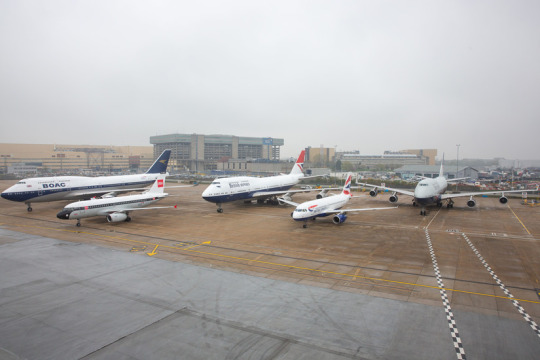
image: British Airways
There is a reason that two of British Airways' fleet of retro liveries wear wordmarks that say other names. To discuss the history of the British Airways livery, I have to first begin by discussing the fact that British Airways...is a weird airline.

British Airways. IATA code BA, ICAO code BAW, callsign SPEEDBIRD. Flag carrier of the United Kingdom.

Honestly a better logo than at least 40% of actual airlines.
Well, it's actually a subsidiary of the unimaginatively named International Airlines Group, Europe's third-largest airline holding company, below Ryanair and the Lufthansa Group but ahead of Air France-KLM. IAG is a member of the oneworld alliance and is the parent company of British Airways, Iberia, Aer Lingus, Vueling, and LEVEL, and just last year acquired Air Europa and began the process of absorbing it away from SkyTeam. To anyone who may have had the thought enter their head: yes, they do now basically have a monopoly on Spanish airlines. To any Spaniards reading, my condolences. At least you still have EasyJet.
Their largest shareholder is Qatar Airways, so when you really think about it British Airways is kind of a subsidiary of Qatar Airways a little bit. Their share is still only 25%, though, so that actually just completely isn't true, but in a vibes sense it feels that way from the outside looking in. Of course, all these airlines have maintained their own identities and operate independently. This is not a LATAM situation. British Airways adopted its present-day livery long before it merged with Iberia to form the IAG in 2011. I'm still not totally sure why they did that. Maybe they wanted to one-up Air France. Iberia's not exactly KLM, but - no, this is not that post.

British Airways. I've always thought it was a little bit strange that it was called that. Few places love reminding the world they're at least nominally still a monarchy more than England. KLM isn't the only airline with 'Royal' in the name - Royal Air Maroc, Royal Jordanian Airlines, and Royal Brunei Airlines are just a few other examples. And yet the United Kingdom has never had an airline, at least not a major one, named anything like The Queen's Royal Air Fleet, which is what I would have expected of them. No. British Airways.
There's not much gravitas to that, is there? Not really any punch. Nothing making it better than Air France. 'British Airways' is a pretty sterile name for a flag carrier.
Their callsign is SPEEDBIRD, though. And that's not sterile. That's awesome. That's Europe's equivalent to Pan Am's CLIPPER or China Airlines' DYNASTY, just pure style. But what is a speedbird, other than a really cool name for a jet?

This is a speedbird. Rather, this is the logo for Imperial Airways. Not to be confused with the very strangely named 1964-1986 Californian commuter airline Imperial Airlines, Imperial Airways was a very early precursor to what British Airways is now. In the inter-war years it served destinations like South Africa, Hong Kong, and Australia - the sorts of places two dozen or so wealthy individuals of power might have reason to go quickly. Unlike Imperial Airlines, Imperial Airways had a very fitting name.
So here's another weird thing about British Airways: it's young. Really young for what it is. Most flag carriers are pretty old, and the few exceptions are airlines founded in the 21st century to replace flag carriers which went defunct in the 90s and on, like Brussels Airlines or ITA Airways. Even when you discount centenarians like KLM and Finnair, most of the names you'd recognize in the rest of the world (and plenty you probably haven't heard of) existed by the 1940s, with the major Axis powers being forced to reboot theirs in the 50s. Even the places Imperial Airways served, despite not having the resources of an empire at their disposal, have far older flag carriers. British Airways didn't exist until 1974, making it younger than my mother, the Boeing 747, the Twin Towers, 2001: A Space Odyssey, and the moon landing.
The primary reason for this was, as far as I can tell, bureaucratic shuffling about, but I'm not especially well-versed or interested in the history of UK corporations so that's where I'll leave this bit off. It is possible, and indeed likely, that someone reading this has the urge to say that I'm being uncharitable and that British Airways is functionally just BOAC or BOAC is just functionally Imperial Airways (or maybe nobody thinks that - I simply don't know enough about the corporate side of it to confidently dismiss the possibility of this indeed being the case). It's just not relevant because I'm ultimately here to talk about the airline as an entity in the public eye that has a livery, and in this sense Imperial Airways, British Airways, and the intermediate steps are fully distinct. So, for my taste, British Airways began operations less than a month before the release of the novel "Carrie". That's strange. British Airways is strange.
Still, even though in most other cases the process was significantly faster, very few flag carriers we'd recognize today were founded outright in their current state.
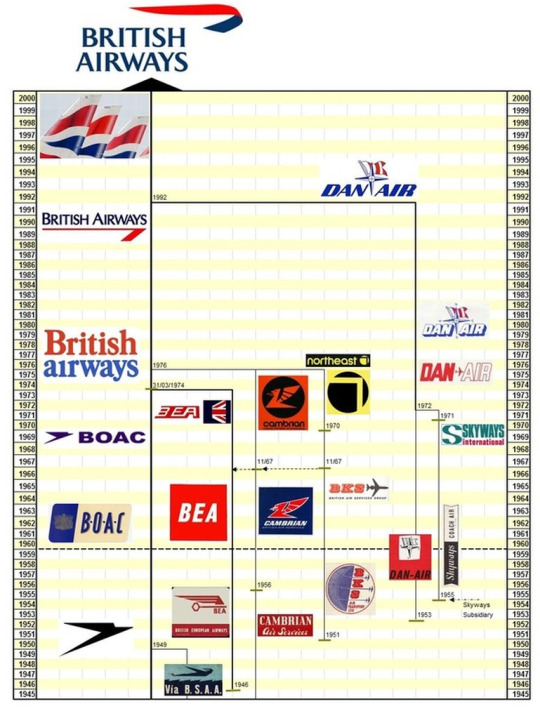
This timeline, compiled by Yesterday's Airlines, documents the 'family tree' of airline mergers that has built up today's British Airways. It actually goes back far earlier. Debatably it began with manufacturer Airco and its subsidiary airline Aircraft Transport and Travel, founded in 1916. Though it went under in 1920, its assets were repurposed by Daimler Airway (singular), which was one of the four airlines (mostly all subsidiaries of aircraft manufacturers) which in 1924 became Imperial Airways. That's right, even the building blocks on this chart are themselves built from blocks!
There are plenty more long-forgotten airline mergers beneath where this graphic cuts off, but this is all to say that the speedbird emblem originated with Imperial Airways, and it has floated to the top of this soup of assorted vaguely British brands, many of which nobody has thought about in decades. Speedbird aside, British Airways resembles basically none of its component parts in any ways that aren't just explained by them both being British, and Airways.
The speedbird was created by notable art deco designer Theyre Lee-Elliott, who created several pieces of iconography and many graphics and posters for the UK government, among other things, like the first-edition cover of "A Farewell to Arms" that an English teacher of mine once had as a poster on her wall. Much of his early work was for airlines, and the speedbird happened to stick.

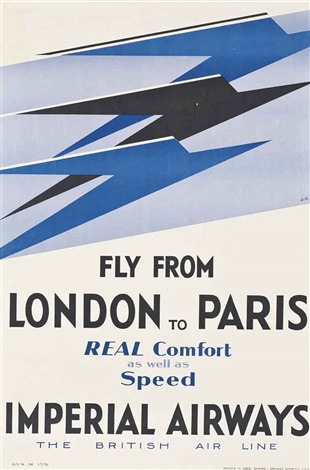
Left poster isn't anachronistic - 'British Airways' was the name of a late-30s airline, itself merged from three other airlines, which would go on to join Imperial Airways as one of the components of BOAC.
Airlines didn't really have liveries as we know them now back when the speedbird was invented, so it would lie dormant as an emblem used on posters and signage for a little while. It was the only part of Imperial Airways' identity which survived when, in 1939, it merged into the British Overseas Airways Corporation.

'British Overseas Airways Corporation' has the same nostalgic punch to it as 'Pan American World Airways'. It was almost always just called BOAC, though, even in the wordmarks of its airplanes. When BOAC came into being the airplane livery was not what it is today. They began with just a painted tail and cheatline, scarcely worth showing or commenting on.
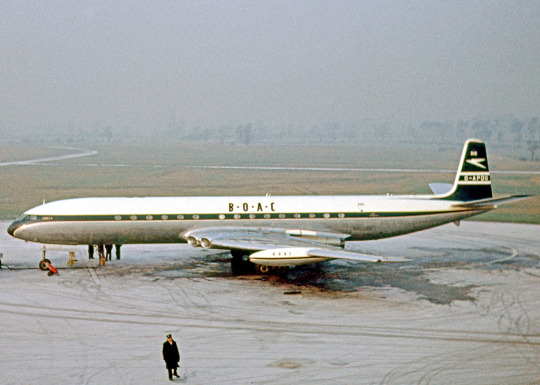
image: RuthAS Okay, I'll show it, but I don't think it needs any further comment.
There's only one BOAC livery that was really recognizable a BOAC livery. It was still fairly boring. More like BOA(rin)C(g). (That one needs work.)
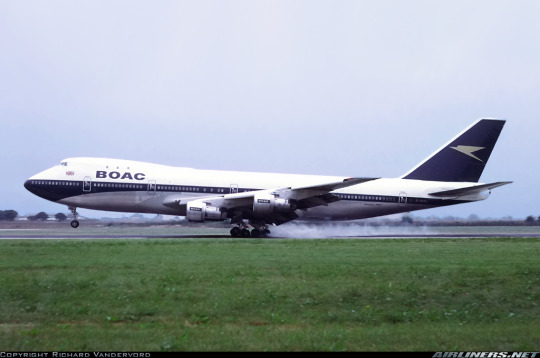
The only interesting thing about the BOAC livery, to me, is the way that sort of face mask shape combined with the tail almost gives it a sort of diagonal symmetry - the front with a blue dip below the white center, the end with a peak above it. It is a very efficient and deceptively effective, potentially unintentionally, use of geometry. I also appreciate the restraint of sticking to blue and white and leaving out red. The minimal nature of it increases the geometric feeling, really saving this livery from my complete disdain. The speedbird logo is really well-centered on the tail, feeling almost like a diagonal slash cut right through it, and I like the use of greyish gold instead of white, which makes it appear less jarring while still being clearly visible. For its day, these positives are certainly not to be fully ignored, though saying that this is a pretty alright 60s white-and-blue cheatline livery is not that high of a compliment. It is cleanly done but in no way exceptional, with a neat bit of art deco angularity to it that you really only notice if you stare at pictures of airplanes as a hobby.
On the other hand, it has a nothing wordmark that honestly just irritates me by breaking up that big clean white block in the same way an old scratch breaks up the flatness of an iPhone screen and it does that thing I hate where a cheatline sort of just...trails off under the tailplane that a fair number of 747 liveries do. It feels like they just couldn't think of anything to do with the end of the plane, which is never what you want from a livery, especially not from an airline that takes itself as seriously as BOAC did. It also uses the isolated tail block, which is a design feature I dislike. At least the extreme matteness of BOAC's midnight-blue-on-white makes it a bit less awful, and the white forward trim is a nice touch.
On balance, I'll give it a BOAC-. That is referring, of course, to the face mask livery, which I think is straddling the fence between 'adequate' and 'forgettable'. I truly have so little to say about the earlier liveries that I'm not going to even give them a grade.

The BOAC livery briefly flew again in 2019 (which British Airways claims to be centenary based on the foundation of Aircraft Transport and Travel, except I've mainly seen that said to be 1916 and most people's consensus is that British Airways was founded in 1974 and no earlier) when it was painted on the 747-400 registered G-BYGC. She was the last 747 to fly for British Airways, just a year after the livery was applied, and there were plans to preserve her in the heritage livery which never materialized. Sadly, she was scrapped in late 2023.
But there was that speedbird on the tail! The speedbird was so damn iconic that it was even BOAC's callsign. So where did it go?
We'll get to that. There's more to British Airways than BOAC.
BOAC was state-owned, and it held a place of national prominence...so it was the flag carrier, right?
Sort of. It was a flag carrier. BOAC was the UK's Pan Am, specializing in long-distance international flights (hence 'overseas' in the name). There was also British South American Airways, a short-lived national carrier which was absorbed into BOAC after two years, with its most notable contributions to history being the disappearances of its planes Star Tiger and Star Ariel, but a significantly more enduring brand was BEA.
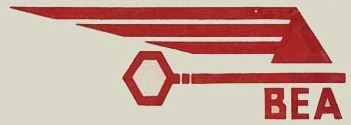
This initial logo, also the work of Theyre Lee-Elliott, had a key motif to accompany BEA's slogan, 'the key to Europe'. I adore it. I like BEA a lot.
While initially founded as an offshoot of BOAC (which I suppose was the singular flag carrier from 1939 to 1946), British European Airways Corporation specialized in, as the name implied, flights within Europe (and other relatively nearby destinations). It was something of a VASP-and-VARIG situation. Nobody ever called it BEAC, though, even though it sounds like 'beak' and birds are a whole thing, because...flying...well, look, we can all understand, in retrospect, that one of the great tragedies of aviation history is that I wasn't there to have ideas. That said, maybe it's a good thing I never planted this seed, because their callsign was BEALINE, which is...just the most adorable thing I think I've ever heard. It genuinely makes me smile. It may be my favorite ever callsign.

They did eventually change their official name to just British European Airways. Sort of a shame, if you ask me - you could have been twinsies. Ah, well. Also a shame is the perplexing choice to shelve their rather nice and meaningful original logo and replace it with what I can generously describe as 'a square' in 1957. I think SAS did it better. I can't rule out that I just hate it because the old one was so much better, though. I've seen far uglier, but again - this is a square.

image: Adrian Pingstone
When it's on the livery, it's not even well-aligned! And it's difficult to imagine negotiating this onto an aircraft tail, even when dealing with a generously square fin like the Trident's. (BEA loved their Tridents, which were essentially designed for the airline's operations, and operated 70 of the 117 airframes completed. This makes me like them, because I love the Trident too.) That said, I think that if you're using a logo that is just the name of your airline, putting it on the tail rather than the front side fuselage is a bold move. Today it rarely pays off, but in the era of cheatlines and half-bare planes it actually avoids the issues of legibility and vertical space that a lot of other contemporary liveries struggled with.
Still, the square. It will simply never not look strange to have two straight vertical lines on a fin that's more or less diagonal to them, and I'm not sure how that could be fixed. They did the best they could, I think, but this was just doomed from the start.
On the other hand, I do enjoy its placement within the cheatline. It helps keep a sense of pace but doesn't break up the line, and it just feels like it clicks into place in a way I love. I like the continuity with the black line at the tip of the horizontal stabilizer, and I like that the white paint doesn't extend down as far as on a lot of liveries of the time, leaving the cheatline to taper above the Trident's rear-mounted engines instead of underlying them as many other airlines' did.
This logo and livery were designed by Mary de Saulles, who was trained as an architect rather than a graphic designer. I think it shows in the very simple shapes and lines present here, and it also shows in the fact that despite it technically not doing anything too unusual the BEA livery was very distinctive when actually on the apron.
BEA's liveries weren't terribly more innovative than BOAC's at first glance. But their black-and-red 60s livery was actually, deceptively, a standout of the era.


images: Ralf Manteufel | Adrian Pingstone
The red wings on BEA's aircraft were absurdly stylish. There are dozens of reasons involving weight and heat and aerodynamic properties that prevent airlines from painting the wings on their airliners anything but a very dull drab, and I despise it, but when even the all-black Air New Zealand plane has white wings it begins to feel like it's just not possible to do anything else. Actually, it is hypothetically possible, though expensive, as long as you avoid the leading edges, though I'm sure the margins for shape and weight of a wing are far more precise on a 787 than they were on a Viscount. Still, I can't help but wish airlines would swallow the costs of painting wings (not like liveries aren't already a needless expense if you're trying to really optimize), because just look at this. It's absolutely stunning. It brings BEA's livery all the way from completely forgettable to by far the most eye-catching in the approach pattern.
And, you know what? I'll give them a BEA for that.
It might seem like a bit of a strange evaluation when I spent two paragraphs complaining about that square, but just imagine being on the ground and seeing a Comet landing, the lack of underwing pylons leaving that big red wing, like the lining of a cloak. That's a real Riyadh Air first impression. So while yes, the square is a square and certain aspects of the livery's implementation on various models range from forgettable to clunky, I am disregarding all of that, because this is like Dracula showing up to a board meeting. They are literally flying Louboutins.
BEA's livery and branding evolved over time in a way BOAC just didn't. BOAC never had anything I would identify as a 'rebranding' - it sprang fully formed from the Queen's (or something) head and stayed in its pristine state until the day it abruptly vanished. This was not quite the case for BEA.

image: Adrian Pingstone This is a preserved airframe, hence the very anachronistic car models in the foreground. Still, the livery is accurate.
Their final livery, introduced 1968, was this - the 'speedjack' livery. The speedjack is, more specifically, that delightfully pointed Union Jack emblem on the tail. I do like the speedjack itself, being one of the only decent uses of a Union Jack base I've ever seen. It feels obvious yet brilliant to turn the intersecting lines of the flag into an arrow shape. Unfortunately, far more was changed than just the logo.
My beloved flying Louboutin was gone. They still sometimes had the red wings at this point, but in every other way it was a new livery. I actually find that something is lost here, because the old BEA livery had red but not blue, and the BOAC livery had blue but not red, so they were sort of a matching set. Also, um, that wordmark is legitimately hideous.

It's a bit less horrible when it's not red letters on a white background, at least. And it does have a forward slant, a continuity...but this lacks the brilliance of Lee-Elliott's key or the charm of the de Saulles square.
The speedjack, logo, and livery were created by FHK Henrion, whose work has appeared on this blog before, though I failed to mention it. He designed the KLM crown logo!

...a logo I used to think was fine until learning about the absolute beauty they had from 1930 to 1938. Henrion designed the totally palatable 1961 version, and further modifications were made by the firm Henrion, Ludlow & Schmidt, with at least the 1991 change being the work of Ludlow. It's certainly gone downhill, but maybe I just think that because of how much I adore the 1930 iteration.
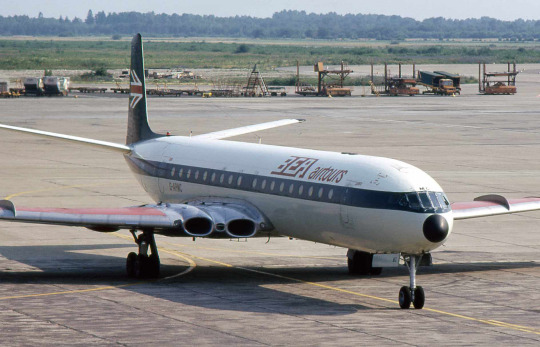
image: Piergiuliano Chesi
As for BEA - at the very least they kept the red wings. This is sort of a double-edged sword, though. This livery was, overall, far less distinct from its surroundings than the de Saulles livery, and the addition of the lighter blue to the fuselage really dulls the impact of the red against the stark black it used to share the airframe with. It just feels...flat. Neutered. Like an interim livery when one airline has bought out another and the paint jobs are changed out piecemeal. (And I think a red-only speedjack on a black tail would look fantastic, for the record.)
The details aren't much better. The cheatline feels almost too thin for the cockpit windows and the tiny wordmark makes the white fuselage feel as empty as it is without the little BEA logos making sure that isn't what you're focused on. Some models, like the Trident Three and Super One-Eleven, get their status indicated by text on the tail that looks like the default font of a word processor. It's just sloppy. Henrion's effort went to the speedjack, where a firm which specializes in image identity generally would be directed, and some interest was taken in the wordmark, but the livery itself feels like a pieced-together afterthought.
This gets a grade of...please just go back. I want to say D+.
How much of that grade comes from genuine dislike of the Henrion livery versus just thinking it's worse than what came before, I don't know, but it's one of the most immediate downgrades I've ever seen and the attempt to keep the most striking feature of the old livery while sapping it of its power feels almost insulting. It feels messy and pieced-together, and it's angling dangerously close to having the same approximate color layout as the old SAS livery - you know, the only thing that's ever failed the Star Alliance Test.

And, at least from the side, and from farther away, it really doesn't fail the Star Alliance Test. It's serviceable, and I wouldn't be nearly this harsh on it if I didn't know what came before. But I've committed to a chronology of what would become British Airways, so I have to mention both, and that includes looking at them, reading about their design processes, and forming detailed opinions of them. This livery was just doomed by its predecessor.

Even British Airways seems to agree with me, given that when they painted an A319 (G-EUPJ) in a BEA retro livery they chose the older black-and-red. Some liveries are simply iconic. Some simply aren't.
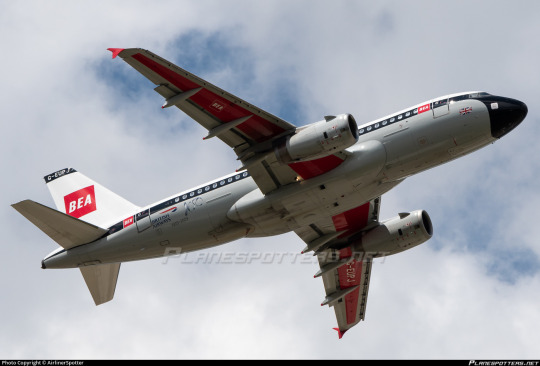
And, yes - the wings are red. At least, the bottom is. The top was forced to remain grey for reasons of 'reflectivity', which is fairly vague. Still, this should be a sign to other airlines - your planes will make an impression from below, and that impression could be as powerful as the one BEA used to make.
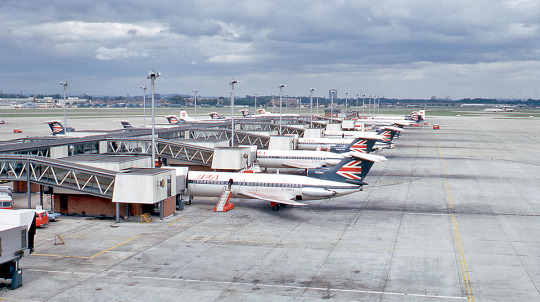
image: Ben Brooksbank
BEA, at its height, flew more passengers than any other airline in Europe. It had subsidiaries, including...Cyprus Airways. (Yes, the same one that's still the flag carrier of Cyprus. That's its own story.) They even operated helicopters.

image: RuthAS Cursed? You decide.
And then, as the 70s began, the decision was made to merge the two state-owned airlines - something which I would personally have done earlier, and apparently people did try to do earlier but were prevented from doing by...politics. You know, just a couple people with titles that begin with 'Secretary of' passive-aggressively fighting over financial things. In 1974, what was probably inevitable finally became a reality.
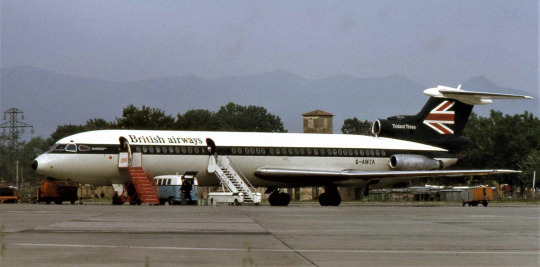
image: Piergiuliano Chesi
It takes a while to repaint a full airframe. When two airlines merge the change is often done bit by bit, making sure the wordmark's right but not bothering with the rest. In 1975, G-AWZA, pictured here, still wore the speedjack, but the wordmark above her cheatline said something new entirely, and a new airline was using the callsign SPEEDBIRD.

And this is where I will conclude today, thwarted by image limit. Of course, being the person I am, I couldn't help but make my return for the new year not just a two-parter but a three-parter. Having dispensed with the British Airwayses that weren't British Airways, part two will cover the British Airways of the surprisingly recent past.
In the meantime thank you to all readers, old and new. I'm thrilled to be back from my break, and I hope you'll stick around for another year of Runway Runway.
#tarmac fashion week#region: west/central europe#region: united kingdom#grade: a#grade: c-#grade: d+#british airways#british european airways#boac#double sunrise#era: 1950s#era: 1960s#era: 1970s#klm royal dutch airlines#imperial airways#long haul
38 notes
·
View notes
Text
In the waters of the South China Sea, Chinese coast guard vessels have clashed with Philippine ships. In the air above the Taiwan Strait, Chinese warplanes have challenged Taiwanese jet fighters. And in the valleys of the Himalayas, Chinese troops have fought Indian soldiers.
Across several frontiers, China has been using its armed forces to dispute territory not internationally recognized as part of China but nevertheless claimed by the Chinese Communist Party (CCP).
In August 2023, Beijing laid out its current territorial claims for the world to see. The new edition of the standard map of China includes lands that are today a part of India and Russia, along with island territories such as Taiwan and comprehensive stretches of the East and South China Seas that are also claimed by Brunei, Indonesia, Japan, Malaysia, the Philippines, and Vietnam.
China often invokes historical narratives to justify these claims. Beijing, for example, has said that the Japanese-administered Senkaku Islands, which it claims under the name of the Diaoyu Islands, “have been an inherent territory of China since ancient times.” Chinese officials have used the same words to back China’s right to parts of the northeastern Indian state of Arunachal Pradesh. The Chinese government also claims that its sovereignty over the South China Sea is based on its own historic maritime maps.
However, in certain periods since ancient times China has also held sway over other states in the region—Mongolia, North Korea, South Korea, and Vietnam. Yet Beijing is currently not laying claim to any of these.
Instead, Beijing has embraced a selective irredentism, wielding specific chapters of China’s historical record when they suit existing aims and leaving former Chinese territories be when they don’t. Over time, as Beijing’s interests and power relations have shifted, some of these claims have faded from importance, while new ones have taken their place. Yet for Taiwan, Chinese claims remain unchanged, as the fate of the island state is tied to the very legitimacy of the CCP as well as the vitality of Chinese President Xi Jinping’s political vision.
Many of the CCP’s territorial claims have roots in the 19th and 20th centuries during the late rule of the Qing Dynasty. Following diplomatic pressure and repeated military defeats, the Qing Dynasty was forced to cede territory to several Western colonial powers, as well as the Russian and Japanese empires. These concessions are part of what are known in China as the “unequal treaties,” while the 100 years in which the treaties were signed and enforced are known as the “century of humiliation.” These territorial losses eventually passed from the dynasty to the Republic of China and then, following the Chinese Civil War, to the CCP. As a result, upon the CCP’s establishment of the People’s Republic of China in 1949, the new Chinese state inherited outstanding territorial disputes with most of its neighbors.
But despite the humiliation the Qing Dynasty’s losses had caused, the CCP proved willing to compromise and reduce its territorial aims during times of high internal unrest. Following the Tibetan uprising in 1959, for instance, the CCP negotiated territorial settlements with countries bordering the Tibet region, including Myanmar, Nepal, and India. Similarly, when unrest rocked the Uyghur region in the 1960s and ‘90s, Beijing pursued territorial compromises with several bordering countries such as Afghanistan, Kazakhstan, Kyrgyzstan, and Tajikistan. In the aftermath of the Great Leap Forward in the early 1960s and the 1989 Tiananmen Square Massacre, the CCP also pursued territorial settlements with Mongolia, Laos, and Vietnam in the hopes of securing China’s borders during times of domestic instability. Instead of pursuing diversionary wars, the CCP relied on diplomacy to settle border and territory disputes.
But China has changed quite a lot since then. In recent years, the CCP has avoided the inflammatory domestic political chaos of previous decades, and its once-tentative hold over border regions, such as Tibet and the Uyghur region, has been replaced by an iron grip. With this upper hand, the CCP has little incentive to pursue peaceful resolutions to remaining territorial disputes.
“China’s national power has increased significantly, reducing the benefits of compromise and enabling China to drive a much harder bargain,” said M. Taylor Fravel, a political science professor at the Massachusetts Institute of Technology.
In this context, the CCP has expanded its irredentist ambitions. After the discovery of potential oil reserves around the Senkaku Islands, and the United States’ return of the islands to Japan in the 1970s, Beijing drew on its historical record to lay claim to the islands, even though it had previously referred to them as part of the Japanese Ryukyu Islands. Similarly, though Beijing and Moscow settled a dispute over Heixiazi Island, located along China’s northeastern border, in 2004, the 2023 map of China depicted the entire island (ceded, along with vast Pacific territories, by the Qing Dynasty to the Russian Empire in 1860) as part of its domain, much to the ire of the Russian Foreign Ministry.
Collin Koh Swee Lean, a senior fellow with the S. Rajaratnam School of International Studies at the Nanyang Technological University in Singapore, argues that the Chinese mapping of Heixiazi Island shows that Beijing holds on to certain core interests and simply waits for the opportune time to assert them.
“Given the current context of the war in Ukraine and Russia’s increased dependence on China, it might have appeared to Beijing that it has the chips in its pockets because, after all, Moscow needs Beijing more than the other way around,” Koh said on the German Marshall Fund’s China Global podcast.
This raises the question of whether territorial disputes that were settled during times of CCP weakness can be revisited and become subject to irredentist ambitions should power balances shift in China’s favor.
According to Steve Tsang, the director of the China Institute at the University of London’s School of Oriental and African Studies, there is currently a limit to how far the CCP will push territorial claims against Russia, since President Xi will need Russian support to sustain his grand ambitions for Chinese leadership on the global stage.
Although it would be a long shot, even Russia may not be safe from these ambitions indefinitely. Given that large swaths of Russia’s Pacific territories were part of China until 1860, “China could claim back the Russian Far East when it deems the time is right,” Tsang said. Such control would grant Beijing unrestricted access to the region’s abundance of coal, timber, tin, and gold while moving it geographically closer to its ambition of becoming an Arctic power.
While there is plenty of historical evidence pointing to former Chinese control over the southeastern portion of the Russian Far East, the historical record is less unequivocal about Chinese control over Taiwan. Anything resembling mainland Chinese control over Taiwan was not established until after 1684 by the Qing Dynasty, and even then central authority remained weak. In 1895, the Qing Dynasty ceded Taiwan to the Empire of Japan following the First Sino-Japanese War, and by the time Chinese authority was restored in 1945, Taiwan had undergone several decades of Japanization.
These details have not prevented the CCP from claiming that Taiwan has been an inalienable part of China since ancient times. Yet more than any other irredentist claim, Xi has made unification with Taiwan a major component of his vision to rejuvenate the Chinese nation.
Unification, however, has little to do with ancient history and more to do with the challenge that Taiwan presently poses to Xi’s aims, according to Chong Ja Ian, an associate professor who teaches about Chinese foreign policy at the National University of Singapore.
“The CCP pursues a Chinese nationalism that emphasizes unity and homogeneity centered around the CCP leadership while they also often claim that their single-party rule is acceptable to Chinese people,” Chong said.
In contrast, Taiwan holds free elections in which multiple political parties compete for the favor of a people that have increasingly developed an identity distinct from mainland China.
“The Taiwanese experience is a clear affront to the CCP narrative,” Chong said.
Control over Taiwan is also attractive to Beijing because it is key to unlocking the Chinese leadership’s broader ambition of maritime hegemony in waters where almost half of the world’s container fleet passed through in 2022.
As with the case of Taiwan, the CCP’s historical arguments regarding its claims on island groups and islets in the East and South China Seas are likewise much weaker than many of its land-based claims.
Instead, Chinese territorial intransigence in the maritime arena is more about a strategic shift in the value of the seas around China, Fravel said.
Today, it has been estimated that more than 21 percent of global trade passes through the South China Sea. And beneath these waters are not only subsea cables that carry sensitive internet data but also vast estimated reserves of oil and natural gas.
Although it may say otherwise, Beijing’s unwillingness to let up on its tenuous territorial maritime claims suggests that China is pursuing long-held ambitions and global aspirations rather than attempting to reverse past losses. So long as the CCP wields its historical record selectively and changeably to serve its aims—and is willing to back its claims up with military action—China’s neighbors will remain at risk.
22 notes
·
View notes
Text

Borneo is the largest island in Asia, with a rich history and diverse ethnic groups such as Dayak, Malay, Bajau, Kedayan, Banjar, Kadazandusun and many more.
Borneo, a land blessed with wildlife and unparalleled natural beauty as well as abundant natural resources.
At an estimated 130 million years old, Borneo's rainforest is two times as old as the Amazon rainforest in South America.
Evidence for prehistoric human occupation of Borneo has been found at Neah Cave in Sarawak, including fossil bones, stone tools, and wall and ceiling paintings. Borneo is first mentioned in Ptolemy’s Guide to Geography of about 150 CE. Roman trade beads and Indo-Javanese artifacts have been discovered that give evidence of a flourishing civilization dating to the 2nd or 3rd century CE. Three rough foundation stones with an inscription recording a gift to a Brahman priest dated from the early 5th century, found at Kutai, provide evidence of a Hindu kingdom in eastern Kalimantan. Brahmanic and Buddhist images in the Gupta style have been found in the valleys of the Kapuas and other rivers in western Kalimantan. Later Kalimantan rulers were probably feudatories of the Majapahit empire of eastern Java (c. 1293–1520). With the arrival of Islam early in the 16th century, a number of Muslim kingdoms were founded, including the Banjarmasin, Sambas, Sukadana, and Landak. The Sukadana rulers owed allegiance to the Muslim Mataram kingdom of Java.
Modern European knowledge of Borneo dates from travelers who passed through Southeast Asia in the 14th century. The first recorded European visitor was the Franciscan friar Odoric of Pordenone, who visited Talamasim on his way from India to China in 1330. The Portuguese, followed by the Spanish, established trading relations on the island early in the 16th century. At the beginning of the 17th century the Portuguese and Spanish trade monopoly was broken by the Dutch, who, intervening in the affairs of the Muslim kingdoms, succeeded in replacing Mataram influence with their own. The coastal strip along the South China and Sulu seas was long oriented toward the Philippines to the northeast and was often raided by Sulu pirates. British interests, particularly in the north and west, diminished that of the Dutch. The Brunei sultanate was an Islamic kingdom that at one time had controlled the whole island but by the 19th century ruled only in the north and northwest. In 1841 Sarawak was split away on the southwest, becoming an independent kingdom ruled by the Brooke Raj. North Borneo (later Sabah) to the northeast was obtained by a British company to promote trade and suppress piracy, but it was not demarcated until 1912. Those losses left a much-reduced Brunei, which became a British protectorate in 1888.
During World War II the Japanese invasions of Borneo (1941–42) quickly eliminated the token British and Dutch forces on the island, which was not retaken until 1945. In July 1946 both Sarawak and North Borneo were made British crown colonies. In Dutch Borneo a strong nationalist sentiment developed and led to fighting between Indonesian and Dutch forces as the latter attempted to reimpose Netherlands control. Sovereignty passed to the Indonesians in 1949, and in 1950 a new constitution proclaimed Dutch Borneo part of the Republic of Indonesia.
The British government relinquished its sovereignty over Sabah and Sarawak in 1963, when those territories joined the Malaysian federation. That marked the commencement of Indonesian hostilities in the form of guerrilla raids across the border. Those raids ceased by agreement in 1966. Except for the period of Japanese occupation, Brunei remained a British protectorate until 1983. It became fully independent on January 1, 1984.
BORNEO, 1 Island, 3 Countries
8 notes
·
View notes
Text
In the days since Hamas launched a deadly attack on southern Israel on 7 October, the Association of Southeast Asian Nations has not made a formal statement about the crisis. This is not surprising, given that each ASEAN member sees the conflict differently. The language adopted and positions taken by individual ASEAN members reflect the interplay of historical or domestic dynamics in their foreign policy. ASEAN is a grouping – but on this issue, not a bloc.
Let’s look at the diverse response from the ASEAN members – where at one end of the spectrum, Brunei, Malaysia and Indonesia have expressed unity with the Palestinians. None of them has diplomatic relations with Israel and all have remained steadfast in their criticism of Israel despite Western pressure. Malaysian Prime Minister Anwar Ibrahim spoke to Ismail Haniyeh, the political bureau chief of Hamas, and expressed support for an immediate ceasefire in the Gaza Strip.
In each of Malaysia, Brunei and Indonesia, religion is significant in domestic politics. With Muslim majority populations, there is widespread public solidarity with the Palestinian struggles.
The significance of religion in Indonesian domestic politics was compelling enough for Ganjar Pranowo, one of the candidates for next year’s presidential election, to appear during an Islamic prayer call on a private TV station as part of his campaign. Furthermore, recent public demonstrations in Jakarta and Kuala Lumpur against Israel and the United States reflect sentiment on the street about the latest fighting, which governments cannot ignore.
Conversely, Singapore took a firm position against Hamas and strongly condemned the “terror attacks”. The small island-state has close defence relations with Israel, with Israeli military advisers assisting the Singapore Armed Forces since Singapore’s independence in 1965. Defence relations remain strong, as reflected in the joint development and production of surface-to-surface Blue Spear missiles.
Singapore’s strong stance against Hamas leaves it out of step with its larger Muslim-majority neighbours. Bilahari Kausikan, an influential former Singaporean diplomat, made clear the difference by frankly labelling as “bullshit” a view he attributed to a Malaysian ex-diplomat for the “root cause of the current violence” to be addressed, instead supporting a robust Israeli military response against Hamas.
Nevertheless, Singapore is concerned the crisis could lead to domestic division along religious lines as there is a sizable Muslim minority in the island-state. The government has banned events and public assemblies concerning the current Israel-Hamas conflict, citing rising tension as a reason. And to avoid a view that the Singapore position was one-sided, a government minister later said it was possible to be concerned regarding the Palestinian plights while condemning Hamas’ action. The Singaporean President and Prime Minister sent letters to Palestinian leaders, expressing condolences for the mounting casualties in the Gaza Strip, and pledging a $300,000 donation in humanitarian aid.
Two other ASEAN members, the Philippines and Thailand, have large numbers of nationals working in Israel and have suffered casualties in the current crisis. Yet each responded differently. The Philippines condemned Hamas’ actions, while Thailand initially expressed neutrality, stating that “we do not know the truth about the political climate between the two nations [Palestine and Israel].” Manila’s response could be attributed to its experience battling militant groups in the southern Philippines over decades. As recently as 2017, militant groups professing alignment with the Islamic State seized control of Marawi, a city in the south of the Philippines, which led to a months-long campaign by the Philippines military with regional support to drive the militants out.
Across mainland Southeast Asia, Cambodia, Laos and Vietnam issued softer statements, expressing concern about the crisis without assigning blame to any party. The military junta in Myanmar is more focused on regime survival, launching an air strike against domestic insurgents, killing 29 people a few days after the Hamas attack on Israel.
These historical and domestic dynamics inform the policy of individual ASEAN states and provide some perspective in their reading of and response to the current crisis in the Middle East. It demonstrates a lack of unity among the Southeast Asian grouping that some observers argue dilutes its relevance. Yet despite the diverse responses by individual ASEAN members, there has been no official criticism by one member against another. This is consistent with ASEAN’s norms of non-interference in each other’s affairs, which aims to ensure the stability of Southeast Asia, a region that is still experiencing the threat of terrorism, internal rebellions, and inter-state territorial disputes.
Perhaps the silent acceptance of diverse positions is a strategy for ASEAN to cope in the more volatile world that we live in today.
39 notes
·
View notes
Note
🔥 on aph ASEAN?
Philippines: I'm kind of glad that the Philippines turned out to be a guy in canon I know people were upset because a lot of fanon interpretations saw him as being a girl but, idk how to explain it without sounding insane or self hating LMAO but I feel like the Philippines being a guy makes seeing ships like Spain x Philippines and America x Philippines less uhh gross to look at. I mean I definitely don't ship those ships but its leaves a grosser taste in my mouth when I see Spain x woman Philippines for example, purely because we uhh all know what the Spaniards did to the women here lol.
I'm not saying that someones a bad person if they ship those ships I mean at the end of the day it's all fictional and people can do what they want, it's no biggie, I just think a lot of people in the hetalia fandom still don't have the ability to be nuanced about ships between countries with complicated histories. I have yet to see a well done analysis on how Spain x Philippines or America x Philippines would realistically work outside of people shipping it purely because it's a coloniser x colonised ship. I'm sure that a hetalia fan who is informed and can give a nuanced take can probably make me tolerate those ships but for now, no not really. . So if Philippines was a girl I feel like a lot of Spain x Philippines content or America x Philippines content would be a lot more disgusting and f3tishistic because Filipinas are already f3tishised.
Also when it's coloniser x colonised and the only reason why those two countries know each other is because one of them sailed across the world to invade the other one unprovoked, it's different from two nations who are neighbours and who war with each other if that makes sense. I think it would be different if Spain and the Philippines were like, neighbours who've fought each other for centuries and who subjugated each other and maybe I'd even like it if that was so, but it's just not the case (this is all coming from a Filipino)
Malaysia: LOL HE'S A SIMP FOR SINGAPORE (same). But honestly I kind of get it like why did Singapore say that Iceland of all people is his fave like what. Hima why are you trying to shoehorn in random Europeans LMAO
Indonesia: I love him but I wish in the manga he was portrayed a bit more like a Chad lol maybe it's because I'm used to the fanon interpretation of him
Singapore: I don't have strong feelings about him and I like his design but again uhh why is Iceland is fave bro💀 again it just seems like Hima trying to shoehorn in random European nations like shhh Iceland has had his turn being venerated by the fandom let the Asians have their go..
Thailand: No strong feelings about him I love him
Vietnam: Strong feelings about her but none of them are negative I LOVE HER XADKJS I just wish Hima would release a chapter of her just beating up America tho <3
Brunei, Cambodia, Laos and Myanmar I don't have unpopular opinions on really because I don't enough about their characters or how the fandom perceives them
Thank you for the ask :D
#hetalia#hws asean#hetalia world twinkle#hetalia world stars#hetalia world series#hws philippines#hws indonesia#Hws Singapore#Hws Thailand#Hws Vietnam#hws malaysia#Hws Cambodia#Hws Myanmar#Hws brunei#Hws laos#Ask
60 notes
·
View notes
Text
i love being southeast asian.
despite whatever unhappy history, despite the rise of ethnonationalism and racism in our countries; despite the fact that most of us remain in the global south under the invisible thumb of western empires and conglomerates, exploited by rich expats and beg-packers; despite the conservatism, the bigotry, the pain and prejudice and the corruption.
despite all that, i love where i am from. this is my home.
my hands tenderly trace the lines of our history and find within it a colourful collection of influences that continue to shape us until today:
the native malays, javanese, sundanese, minangkabau, bugis, visayan, tagalog, and other dominant peoples.
alongside indigenous tribes like the iban, kadazan, sama-bajau, temuan, penan, jakun, and hundreds upon hundreds more ethnic groups.
all of us holding onto our ancestors' mysticism and spirituality and animism, the watchful gaze of legacy fixed on us as we move through an ever-changing and modernising world (and what is modernity anyway? isn't civilisation overrated?).
and then the chinese peoples. the hainanese, hokkien and cantonese and more, many of whom came here due to trade in the pre-colonial era, but then most arrived as the imported labour for the colonial powers.
but this is their home too. we live here together, and through them we all celebrate lunar new year and the mid-autumn festival. all of us give red envelopes during our many festivals. we give oranges that symbolise prosperity and ring in the year of the rabbit, dragon, snake, horse, goat. we hold lion dance performances in our malls and marks. we eat and exchange mooncakes.
and then the indian peoples, though mostly tamil indians from south india, but also sikhs, malayalis, and punjabis, who arrived and assimilated and spread their culture and beliefs much earlier before the pre-colonial era, causing the indianisation of southeast asia. then more indian peoples came during the colonial era, again, as imported labour, working our fields or donning the uniform of our common oppressors, kept walled away from us despite how alike we look and sound.
because truly we do sound the same. sanskrit remains an abundant source for a large chunk of our languages. i hear the vedic mantras and can pick apart words that sound familiar. hinduism and buddhism still leaves its traces in our cultures even for those of us who've shifted to islam.
and yes, islam. we're not what the west thinks of when they talk about the muslim world, but southeast asia has some of the largest muslim populations in the world. because through trade, since the medieval times, islam came here and with it brought so many arabic influences that has come to shape our languages and customs, with plenty of our cultures having since been morphed around islamic beliefs and ideas. in malaysia and indonesia and brunei (and perhaps even certain parts of the philippines) you'll find a mosque or a prayer room everywhere you go. and every ramadan millions of us fast, every eid all of us dress up and visit each other's houses for feasts and festivities.
then of course came european colonisation at the hands of the portugese, dutch, british (in malaysia and indonesia's case we got all three), spanish, and french their reigns lasting over 400 years. and from them we came european culture and more new languages, english quickly becoming a second language (or even a first language) for so many of us, missionaries building churches and spreading the word of jesus christ as the son of god; with their fair features they draw a line between us and them, between the civilised and the barbarians, between the light-haired light-eyed and the unruly dark-haired dark-eyed.
and then comes world war 2 and the japanese invasion, and for most it was so brutal and violent, and for the rest it was miserable, with famine and inflation but we were forced to sing songs in japanese anyway, to watch their planes fly in the sky towards their enemies, to swallow their ideas in our parched throats.
and then the war ended and wounds began to heal, and then came the 1980s until now with all its shiny technology: nintendo, panasonic, television and anime, and now we have leagues of people learning japanese language and culture anyway, except now it is done wholeheartedly, and as it turns out japanese isn't even that different from our own cultures anyway. houses on stilts made of wood with thatch roofs, making our living from the sea and coast, eating rice for every meal, our phonetics and theirs so alike.
and today we have waves of their expats migrating here because of course they do, we're the Global South™ and for them it's cheap and affordable, so we have little japans sprouting here and there and sometimes i go to a random street and find signs written in japanese and read bits of broken hiragana.
and it's beautiful, being able to move through this world and find the handprints we've all left upon it. it's a wonderful amalgam of so many traditions and colours and beliefs and language all mixing around in this huge bubbling melting pot.
and i'm not chinese or indian or arab or british but when i see them on tv, i'm also seeing a part of me, i hear the words in their tongue and i recognise them as mine, i eat their food and know them as intimately as my own.
but of course our politicians, our kings and our prime ministers (and the divide-and-conquer rule of colonisers now gone) continue to divide us and make us hate each other, fanning flames of distrust and fear of that-which-is-different.
it's such a shame too, because it's so special. it's what makes us us, our dozens of creoles, the way we can speak a sentence comprising vernacular from at least four languages and we all understand each other anyway.
we have a word in malay, "rojak", which is also the name of a dish that mixes a bunch of different ingredients, and is found in malaysian, indonesian and singaporean cuisine. but where i'm from, we also say "rojak" to mean anything that's an eclectic mixture of things, things that seemingly don't go together and aren't necessarily pleasing to the eye but still, somehow, it works, in fact it tastes good, spicy and flavourful and hearty.
and that's us: southeast asia, all of it, a beautiful rojak culture. and it's ours.
#writeblr#people of color#writers on tumblr#writers of color#writing#southeast asia#asian culture#i woke up today and started feeling so many things. i looked around and felt full of love.#but i go on social media and it makes me angry and sad to see how much everyone hates each other#my love is not for what it is but what it could be#lots of my friends wish they could leave. emigrate to australia or UK or US. but even if i could i wouldn't.#this is my home. there is nowhere else.#when i was teaching and i saw those kids' faces it cemented it for me even more.#like if not for anything else i'll stay. i'll do it for them. carve out a community for them. for us.#shut up haydar#scribblings.txt
15 notes
·
View notes
Text
By: Richard Dawkins
Published: Mar 22, 2024
I want to make a three-way distinction. You can be a Cultural Christian, a Political Christian, a Believing Christian, or any combination of the three. People may disagree about which of these constitutes being “A Christian”. For me it has to be Believing Chistian.
I am a Cultural Christian, specifically a Cultural Anglican. I was educated in Christian schools. The history of my people is heavily influenced by Christian tradition. I like singing Christmas Carols, and am deeply moved by the sacred music of Bach and Handel. My head is full of Biblical phrases and quotations. And hymn tunes, which I regularly play by ear on my electronic clarinet.
I think Ayaan Hirsi-Ali (who is one of my favourite people in the world) is a Political Christian. She was brought up in the culture of Islam and is well aware of the horrors that that religion is still visiting on Muslims around the world, especially women. She sees Christianity as a relatively benign competitor, worth supporting as a bulwark against Islam. Just as most of us support a political party without agreeing with all its policies, because we prefer it to the alternative, a Political Christian may support Christianity without being a Believing Christian, because it’s better than the main alternative. Ayaan is a Cultural Muslim, and it is this that has driven her to be a Political Christian.
Believing Christians believe that there is a supernatural creator at the base of the universe called God. They believe a First Century Jew called Jesus is the son of God. They believe Jesus’s mother was a virgin when she gave birth to him. They believe that Jesus came alive again three days after he died. They believe that we ourselves have an immortal soul which survives our bodily death. They believe that God listens to our prayers. I strongly suspect hat Ayaan doesn’t believe any of these things. She is not a Believing Christian.
In my language, that means she is not a Christian at all. Others may include Cultural Christian in their definition of Christian, in which case I am a Christian. Indeed, Ayaan herself is reported to have called me one of the most Christian people she knows. But by the same token, the implication would be that she is a Muslim because she is a Cultural Muslim. And she certainly would not call herself a Muslim.
So, Ayaan is a Political Christian but she is no more a Believing Christian than I am. Her example leads me to consider my own position. Am I a Political Christian? I am in no doubt that Christianity is morally superior to Islam. Just look at the regions of the world with an explicitly Islamic government, or where Islam is the dominant political influence: Iran, Afghanistan, Pakistan, Indonesia, Somalia, Northern Nigeria, Brunei, Turkey (betraying the admirable secularism of its post-Ottoman foundation) Saudi Arabia and many other countries of the Arab world. Laws vary, but recurrent patterns include mistreatment of women as second class citizens, persecution of gays, forced marriage, violent intolerance of what is considered blasphemous, anti-Jewish prejudice going so far as to laud Hitler, draconian punishment for apostasy, and for adultery which is often deemed to include simply talking to a member of the opposite sex other than a spouse or relative. Christianity has its bad points, and in earlier centuries it has been as bad as Islam. But today there’s no contest. When it comes to evil, Islam wins hands down, by a huge margin. No other religion comes close.
If I were American I would vote Democrat because, in spite of their idiotic stance on the male/female distinction, they are hugely preferable to the Republican alternative. Similarly, if I were forced to vote for either Christianity or Islam as alternative influences on the world, I would unhesitatingly vote Christian. If that make me a Political Christian, so be it. I am perhaps as much of a Political Christian as Ayaan is. But does that make either of us a Christian?
In my language, certainly not. For me, as a scientist, truth or falsehood of beliefs is what really defines a word like Christian or Muslim. If you are going to call somebody a Christian without qualification, I think it’s a confusion of language to mean anything less than a Believing Christian. You are at liberty to dissent from that definition. But let us at least be clear what definition we are using. If Ayaan says she’s a Christian and I say she’s not, we are really not disagreeing. We are defining our terms differently. She uses “Christian” to include “Political Christian” for herself and “Cultural Christian” for me. I don’t think you can be a real Christian if you don’t believe the fundmental tenets of Christianity.
The only disagreement is a semantic one. I am a Cultural Christian but not a Believing Christian, which, in my language means I am not a Christian. You, Ayaan, are a Political Christian, which in your language, but not mine, makes you a Christian. But we are neither of us Believing Christian. And this, in my language but not yours, makes neither of us Christians. So, dear Ayaan, let’s not agree to differ. Let’s agree that we don’t really differ.
Dissident Dialogues
I’m happy to say I’ll be having a public conversation with Ayaan Hirsi-Ali at the inaugural Dissident Dialogues. Obviously her announcement that she has become Christian will be a major part of the discussion. The conference will be in New York, May 3rd & 4th. Distinguished speakers include Steven Pinker, John McWhorter, Kathleen Stock, Alex O’Connor, and many other leading thinkers.
#Richard Dawkins#Ayaan Hirsi Ali#christianity#islam#political christianity#cultural christianity#believing christianity#religion#supernatural#religion is a mental illness
6 notes
·
View notes